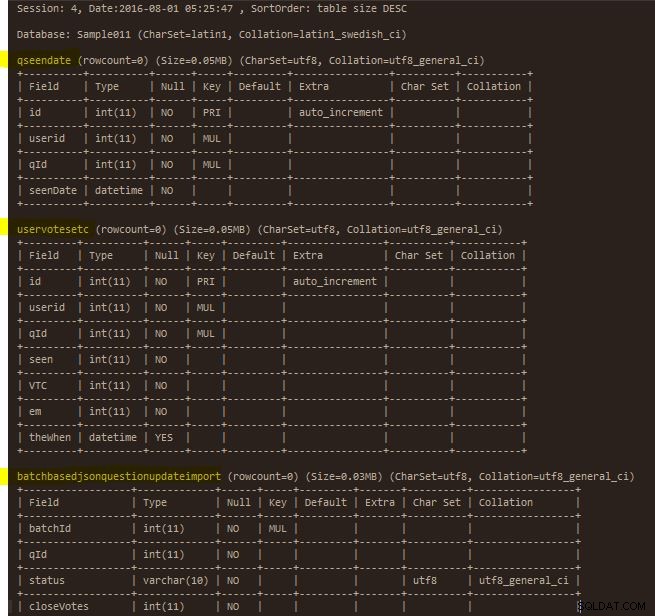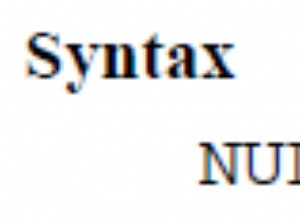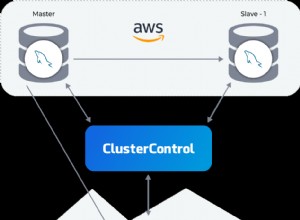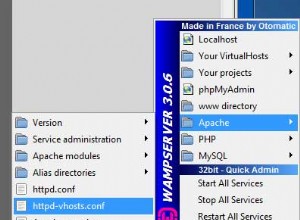Isso expande uma resposta dada Aqui . Ele adiciona as colunas Conjunto de Caracteres e Agrupamento, e o mesmo no nível de Banco de Dados e Tabela. Está incluída a classificação de barebones em duas opções:alfabética e por tamanho de tabela, conforme calculado de forma semelhante a aqui . Eu ainda acho que esse conceito precisa de alguma revisão por pares. Rolando no DBA aqui estava mostrando um método, e Rick James comentou. Não é um cálculo simples e nunca incorpora dados não estáticos, como
TEXT e BLOB s. Portanto, sinta-se à vontade para melhorar esse cálculo e compartilhá-lo. Independentemente disso, as tabelas geralmente retornarão na ordem de classificação desejada se por 'tamanho'. Não garanto sua precisão no que se refere ao tamanho do arquivo InnoDB. Ele permite um stub para você melhorar os recursos de classificação. Por exemplo, tendo outra tabela para junções de ordem de classificação com base em Tabelas principais versus Tabelas de suporte e de código.
Sessões: Isso se baseia no conceito de uma Sessão, que é apenas uma instância de você chamando as rotinas. Pense neles como Snapshots que pode ser acessado posteriormente. Os dados naquele momento estão contidos em um instantâneo de Sessão. Pode ser útil ao alterar tabelas. Em particular, colação. Ah, e sobre o agrupamento, as restrições de chave estrangeira geralmente falham devido a configurações incorretas de agrupamento à medida que os desenvolvedores recortam e colam o código da Internet (conjunto de caracteres em nível de tabela e de coluna e incompatibilidades de agrupamento). É por isso que eu joguei isso nesta versão.
As rotinas vivem em um banco de dados
Reporting101a que abriga os dois procedimentos armazenados e algumas tabelas de suporte (praticamente todas baseadas em sessão). Cerca de 5 mesas. Exemplos de chamada:
call Reporting101a.describeTables_v3('myDb',@theOutVar,false,true,'size')call Reporting101a.describeTables_v3('myDb',@theOutVar,false,true,'alpha')call Reporting101a.Print_Tables_Like_Describe(4,'size')
Consulte NotaA
Parâmetros (1º Proc Armazenado):
- O nome do banco de dados para descrever todas as tabelas.
- o
INTOUTparâmetro para manter a sessão # - boolean:você deseja que os dados sejam excluídos da tabela de relatórios no final
- boolean:devemos chamar automaticamente o procedimento armazenado Pretty Printing que gera
describe-semelhante à saída. - Ordem de classificação:'tamanho' ou 'alfa'. Na verdade, qualquer coisa menos 'tamanho' resultará em 'alfa'.
Parâmetros (Proc Armazenado de Impressão Bonita):
- O número da sessão do instantâneo salvo anteriormente.
- Ordenar como acima.
O código é bastante bem documentado, com exceção de transformá-lo em 600 linhas de código contra 400.
As rotinas são autocontidas e auto-referenciadas no
Reporting101a base de dados. Portanto, chame-os explicitamente de qualquer lugar. ObservaçãoA: Quanto aos exemplos acima:Ex. 1 e 2 como semelhante, apenas uma ordem de classificação diferente. Esta é a sua maneira normal de usá-lo com apenas um ligar. O tamanho da tabela é sempre exibido ao lado do nome da tabela. Somente com 'tamanho' é classificado decrescente nele. Com o 4º parâmetro como True , ele chama automaticamente o Pretty Printing Stored Proc no final. Caso contrário, um conjunto de resultados de Jane simples é renderizado.
@theOutVar será gravado, pois representa a Sessão # criada. Isso é útil para chamar manualmente o procedimento armazenado Pretty Printing logo em seguida, encaixar uma de suas rotinas e usar os dados ou reproduzir os resultados meses depois (do instantâneo congelado). Então, Ex. 3 é o caso em que você deseja recuperar dados para saída com base em uma chamada anterior, tendo sido realimentado um número de sessão. Como nos exemplos 1 e 2 mencionados anteriormente (em que o parâmetro #4 teria sido Falso , Contudo). Ou, se você simplesmente deseja relatar novamente um instantâneo de dados anterior. O uso sugerido é não excluir os dados da Sessão após as chamadas. Assim, deixe o parâmetro #3 como Falso , ou seja, não exclua.
As rotinas não afetam seus dados de forma alguma. Ele apenas modifica os dados no
Reporting101a base de dados. Saída: Se a rotina for executada fora da linha de comando (como no MySQL Workbench), uma coluna wrapper de tabela envolverá a totalidade de todas as tabelas geradas para saída. Tem um cabeçalho de coluna de '' (string em branco). Mas ainda é bastante irritante. Isso é visto em Saída1 mostrado abaixo. No entanto, se você usar a linha de comando interruptores
-N -B (pular nomes de coluna e modo de lote), como com a seguinte chamada:mysql -uYourDBUser -p -N -B -e "call Reporting101a.describeTables_v3('Sample011',@theOutVar,false,true,'size')" > sampleOut.txt
... ele irá gerar uma saída não encapsulada. Mais agradável. Gravado em um
sampleOut.txt Arquivo. Consulte Saída2 abaixo de. Testado em:
5.5 , 5.6.31 e 5.7.13 . Desempenho: Ele usa
CURSORS para a Impressão Bonita. Eu normalmente rio do conceito. Mas, considerando que essas são chamadas infrequentes e um minuto ou dois parecem aceitáveis talvez, fiquei satisfeito ao descobrir que o desempenho está abaixo de 10 segundos para um esquema com 120 tabelas. O Linux é muito mais rápido que o Windows em meus testes. Dois procedimentos armazenados (incluindo o CREATE SCHEMA no topo):
CREATE SCHEMA IF NOT EXISTS `Reporting101a`; -- See **Note1**
DROP PROCEDURE IF EXISTS `Reporting101a`.`describeTables_v3`;
DELIMITER $$
CREATE DEFINER=`root`@`localhost` PROCEDURE `Reporting101a`.`describeTables_v3`(
IN pDBName varchar(100), -- the dbname to report table structures
OUT theSession int, -- OUT parameter for session# assigned
IN deleteSessionRows BOOL, -- true for delete rows when done from main reporting table for this session#
IN callTheSecondStoredProc BOOL, -- TRUE = output is from Pretty output in Second Stored Proc. FALSE= not so pretty output
IN pOrderBy CHAR(20) -- 'ALPHA' OR 'SIZE'. Alphabetical order, or table size order(desc)
)
BEGIN
DECLARE thisTable CHAR(100);
DECLARE beginDT,endDT DATETIME;
SET beginDT=NOW();
DROP TEMPORARY TABLE IF EXISTS Reporting101a.tOutput;
CREATE TEMPORARY TABLE Reporting101a.tOutput
( id INT AUTO_INCREMENT PRIMARY KEY,
tblName VARCHAR(100) NOT NULL,
ordVal INT NOT NULL,
cField VARCHAR(100) NOT NULL,
cType VARCHAR(100) NOT NULL,
cNull VARCHAR(100) NOT NULL,
cKey VARCHAR(100) NOT NULL,
cDefault VARCHAR(100) NULL,
cExtra VARCHAR(100) NULL,
cCharSetName VARCHAR(100) NULL,
cCollName VARCHAR(100) NULL
);
DROP TEMPORARY TABLE IF EXISTS Reporting101a.tOutput2;
CREATE TEMPORARY TABLE Reporting101a.tOutput2
( tblName varchar(100) primary key,
colCount INT NOT NULL,
cFieldMaxLen INT NOT NULL,
cTypeMaxLen INT NOT NULL,
cNullMaxLen INT NOT NULL,
cKeyMaxLen INT NOT NULL,
cDefaultMaxLen INT NOT NULL,
cExtraMaxLen INT NOT NULL,
cCharSetNameMaxLen INT NOT NULL,
cCollNameMaxLen INT NOT NULL
);
INSERT Reporting101a.tOutput(tblName,ordVal,cField,cType,cNull,cKey,cDefault,cExtra,cCharSetName,cCollName)
SELECT TABLE_NAME,ORDINAL_POSITION,COLUMN_NAME,COLUMN_TYPE,RPAD(IS_NULLABLE,4,' '),
RPAD(COLUMN_KEY,3,' '),RPAD(COLUMN_DEFAULT,7,' '),EXTRA,CHARACTER_SET_NAME,COLLATION_NAME
FROM INFORMATION_SCHEMA.COLUMNS
WHERE table_schema = pDBName ORDER BY table_name,ordinal_position;
UPDATE Reporting101a.tOutput
SET cExtra=' '
WHERE cExtra='';
UPDATE Reporting101a.tOutput
SET cField=RPAD(cField,5,' ')
WHERE LENGTH(cField)<5;
UPDATE Reporting101a.tOutput
SET cCharSetName=RPAD(COALESCE(cCharSetName,''),8,' ')
WHERE LENGTH(COALESCE(cCharSetName,''))<8;
UPDATE Reporting101a.tOutput
SET cCollName=RPAD(COALESCE(cCollName,''),9,' ')
WHERE LENGTH(COALESCE(cCollName,''))<9;
INSERT Reporting101a.tOutput2(tblName,colCount,cFieldMaxLen,cTypeMaxLen,cNullMaxLen,
cKeyMaxLen,cDefaultMaxLen,cExtraMaxLen,cCharSetNameMaxLen,cCollNameMaxLen)
SELECT tblName,COUNT(*),0,0,0,0,0,0,0,0
FROM Reporting101a.tOutput
GROUP BY tblName;
UPDATE tOutput2 t2
JOIN
( SELECT tblName,MAX(LENGTH(cField)) AS mField,MAX(LENGTH(cType)) AS mType,MAX(LENGTH(cNull)) AS mNull,
IFNULL(MAX(LENGTH(cKey)),0) AS mKey,IFNULL(MAX(LENGTH(cDefault)),0) AS mDefault,IFNULL(MAX(LENGTH(cExtra)),0) AS mExtra,
IFNULL(MAX(LENGTH(cCharSetName)),0) AS mCharSetName,IFNULL(MAX(LENGTH(cCollName)),0) AS mCollName
FROM Reporting101a.tOutput
GROUP BY tblName
) x
ON x.tblName=t2.tblName
SET t2.cFieldMaxLen=x.mField,t2.cTypeMaxLen=x.mType,cNullMaxLen=x.mNull,cKeyMaxLen=x.mKey,
cDefaultMaxLen=x.mDefault,cExtraMaxLen=x.mExtra,cCharSetNameMaxLen=x.mCharSetName,cCollNameMaxLen=x.mCollName;
CREATE TABLE IF NOT EXISTS Reporting101a.reportDataSessions
( -- For the purpose of safe session auto_inc usage, timings, and rowcount
-- Please don't delete unless you want the sessions to experience aberrant behavior.
-- That is, the inability to report on prior sessions run. Which is no big deal.
sessionId INT AUTO_INCREMENT PRIMARY KEY,
dbName VARCHAR(100) NOT NULL,
-- character_set_name VARCHAR(100) NULL,
-- collation_name VARCHAR(100) NULL,
creationDT DATETIME NOT NULL,
partA_BeginDT DATETIME NULL,
partA_EndDT DATETIME NULL, -- See the following for fractional seconds:
partB_BeginDT DATETIME NULL, -- http://dev.mysql.com/doc/refman/5.7/en/fractional-seconds.html
partB_EndDT DATETIME NULL,
rowCount INT NULL
);
CREATE TABLE IF NOT EXISTS Reporting101a.reportDataColumns
( sessionId INT NOT NULL,
tblName VARCHAR(100) NOT NULL, -- Tablename
ordVal INT NOT NULL, -- the "position number" of the Column
cField VARCHAR(100) NOT NULL, -- The Column
cType VARCHAR(100) NOT NULL, -- Datatype
cNull VARCHAR(100) NOT NULL, -- Nullability
cKey VARCHAR(100) NOT NULL, -- Key info
cDefault VARCHAR(100) NULL, -- Default value
cExtra VARCHAR(100) NULL, -- Extra output
cCharSetName VARCHAR(100) NULL, -- Default value
cCollName VARCHAR(100) NULL, -- Extra output
colCount INT NOT NULL, -- the columns here and below are de-normalize data
cFieldMaxLen INT NOT NULL,
cTypeMaxLen INT NOT NULL,
cNullMaxLen INT NOT NULL,
cKeyMaxLen INT NOT NULL,
cDefaultMaxLen INT NOT NULL,
cExtraMaxLen INT NOT NULL,
cCharSetNameMaxLen INT NOT NULL,
cCollNameMaxLen INT NOT NULL
);
CREATE TABLE IF NOT EXISTS Reporting101a.reportDataTables
( sessionId INT NOT NULL,
tblName VARCHAR(100) NOT NULL, -- tablename
character_set_name VARCHAR(100) NULL, -- table-level default char set
collation_name VARCHAR(100) NULL, -- table-level default collation
rowcount BIGINT NULL, -- rowcount (subject to system refresh, ditto, next column)
tblSizeMB DECIMAL(14,2) NULL -- in MB
);
CREATE TABLE IF NOT EXISTS Reporting101a.reportDataDatabases
( sessionId INT NOT NULL,
dbName VARCHAR(100) NOT NULL, -- Tablename
character_set_name VARCHAR(100) NULL, -- db-level default char set
collation_name VARCHAR(100) NULL -- db-level default collation
);
-- For lack of a better notion, we are calling calls "sessions". The programmer calls the
-- First Stored Proc, and we call that a session after we get a unique next incrementing number.
-- That number is the session #. House all output with that as a column value. This allows us to
-- move between stored procs, have safe output, have historical snapshots, and retain the data
-- via a session # for later use, whatever use.
INSERT Reporting101a.reportDataSessions(dbName,creationDT) VALUES (pDBName,now());
SET @mySession=LAST_INSERT_ID(); -- there it is, our session # (read the above paragraph)
INSERT Reporting101a.reportDataColumns(sessionId,tblName,ordVal,cField,cType,cNull,cKey,cDefault,cExtra,cCharSetName,cCollName,
colCount,cFieldMaxLen,cTypeMaxLen,cNullMaxLen,cKeyMaxLen,cDefaultMaxLen,cExtraMaxLen,cCharSetNameMaxLen,cCollNameMaxLen)
SELECT @mySession,t1.tblName,t1.ordVal,t1.cField,t1.cType,t1.cNull,t1.cKey,t1.cDefault,t1.cExtra,t1.cCharSetName,t1.cCollName,
t2.colCount,t2.cFieldMaxLen,t2.cTypeMaxLen,t2.cNullMaxLen,t2.cKeyMaxLen,t2.cDefaultMaxLen,t2.cExtraMaxLen,t2.cCharSetNameMaxLen,t2.cCollNameMaxLen
FROM Reporting101a.tOutput t1
JOIN Reporting101a.tOutput2 t2
ON t2.tblName=t1.tblName
ORDER BY t1.tblName,t1.id;
INSERT Reporting101a.reportDataTables(sessionId,tblName,character_set_name,collation_name,rowcount,tblSizeMB)
SELECT DISTINCT @mySession,tblName,NULL,NULL,NULL,NULL
FROM Reporting101a.reportDataColumns
WHERE [email protected];
-- http://dev.mysql.com/doc/refman/5.7/en/collation-character-set-applicability-table.html
-- TLDR; A collation can map to a character set
UPDATE Reporting101a.reportDataTables rdt
JOIN INFORMATION_SCHEMA.`TABLES` ist
ON ist.TABLE_SCHEMA=pDBName AND ist.TABLE_NAME=rdt.tblName
JOIN INFORMATION_SCHEMA.`COLLATION_CHARACTER_SET_APPLICABILITY` isccsa
ON isccsa.COLLATION_NAME=ist.TABLE_COLLATION
SET rdt.character_set_name=isccsa.CHARACTER_SET_NAME,rdt.collation_name=isccsa.COLLATION_NAME,
rdt.rowcount=ist.TABLE_ROWS,rdt.tblSizeMB=round(((ist.data_length+ist.index_length) / 1048576), 2)
WHERE [email protected];
INSERT Reporting101a.reportDataDatabases(sessionId,dbName,character_set_name,collation_name)
SELECT @mySession,pDBName,DEFAULT_CHARACTER_SET_NAME,DEFAULT_COLLATION_NAME
FROM INFORMATION_SCHEMA.SCHEMATA
WHERE schema_name = pDBName;
DROP TEMPORARY TABLE Reporting101a.tOutput;
DROP TEMPORARY TABLE Reporting101a.tOutput2;
SET [email protected]; -- the OUT var that came in as a parameter
SET endDT=NOW();
UPDATE Reporting101a.reportDataSessions
SET partA_BeginDT=beginDT,partA_EndDT=endDT
WHERE [email protected];
-- ***************************************************************************
-- ***************************************************************************
-- Label "Some_Sort_of_Output":
IF callTheSecondStoredProc=TRUE THEN
-- The caller says to call the second stored proc (for Pretty Printing)
-- This will generate output similar to `DESCRIBE myTable`
-- But remember, it will do it for EVERY table in referenced database
CALL Reporting101a.`Print_Tables_Like_Describe`(@mySession,pOrderBy);
-- The above call just gave you output.
ELSE
-- The caller chose to not auto call the Pretty Printing second stored procedure.
-- Note, the caller can easily call it right after using the OUT parameter.
-- So our output will be a resultset of out reportDataColumns table for this session #
IF pOrderBy!='size' THEN
-- Order by Alpha for any parameter except 'size'
SELECT *
FROM Reporting101a.reportDataColumns
WHERE [email protected]
ORDER BY tblName,ordVal;
ELSE
-- Order By size DESC
SELECT rdc.*
FROM Reporting101a.reportDataTables rdt
JOIN Reporting101a.reportDataColumns rdc
ON rdc.tblName=rdt.tblName and rdc.sessionId=rdt.sessionId
WHERE [email protected]
ORDER BY rdt.tblSizeMB DESC,rdc.tblName,rdc.ordVal;
END IF;
END IF;
-- ***************************************************************************
-- ***************************************************************************
IF deleteSessionRows=TRUE THEN
-- The caller says output rows are NOT needed at this point. Delete them.
-- Note, if this boolean comes in TRUE, you can't call Pretty Printing
-- second stored procedure with the session # because the data is gone.
--
-- Regardless, you are getting something back from "Some_Sort_of_Output" above.
DELETE FROM Reporting101a.reportDataColumns
WHERE [email protected];
DELETE FROM Reporting101a.reportDataTables
WHERE [email protected];
-- Do not delete the row from the Sessions table for now (you can, I'm not atm)
END IF;
END$$
DELIMITER ;
-- *****************************************************************
-- *****************************************************************
-- *****************************************************************
DROP PROCEDURE IF EXISTS `Reporting101a`.`Print_Tables_Like_Describe`;
DELIMITER $$
CREATE DEFINER=`root`@`localhost` PROCEDURE `Reporting101a`.`Print_Tables_Like_Describe`(
IN pSessionId INT,
IN pOrderBy CHAR(20) -- 'size' or 'alpha' (see CURSORs below). Size means Tablesize (see ____).
)
BEGIN
-- Please note: CURSOR stuff must come last in DECLAREs, else "Error 1337: Variable or condition decl aft curs"
DECLARE beginDT,EndDT DATETIME;
DECLARE done INT DEFAULT FALSE;
DECLARE curTable VARCHAR(100) DEFAULT '';
DECLARE bFirst BOOL DEFAULT TRUE;
DECLARE lv_dbName,CharSetName,CollationName,someClueToCaller VARCHAR(100);
DECLARE lv_rowCount,lineCount INT;
DECLARE theSize DECIMAL(14,2);
DECLARE lv_sessionDT DATETIME;
DECLARE lv_tblName,lv_cField,lv_cType,lv_cNull,lv_cKey,lv_cDefault,lv_cExtra,lv_cCharSetName,lv_cCollName VARCHAR(100);
DECLARE lv_ordVal,lv_colCount,lv_cFieldMaxLen,lv_cTypeMaxLen,lv_cNullMaxLen,lv_cKeyMaxLen,
lv_cDefaultMaxLen,lv_cExtraMaxLen,lv_cCharSetNameMaxLen,lv_cCollNameMaxLen INT;
-- -------------------------------------------------------------------------------------------------------------------
-- The below cursor is in Alphabetical Ascending order
DECLARE curAlpha CURSOR FOR SELECT tblName,ordVal,cField,cType,cNull,cKey,cDefault,cExtra,cCharSetName,cCollName,
colCount,cFieldMaxLen,cTypeMaxLen,cNullMaxLen,cKeyMaxLen,cDefaultMaxLen,cExtraMaxLen,cCharSetNameMaxLen,cCollNameMaxLen
FROM Reporting101a.reportDataColumns
WHERE rdt.sessionId=pSessionId
ORDER BY tblName,ordVal; -- ascending order by tablename then the ordinal position of each column (1..n)
-- The below cursor is in Tablesize Descending order, followed by tablename + ordinal position ascending
DECLARE curSize CURSOR FOR SELECT rdc.tblName,rdc.ordVal,rdc.cField,rdc.cType,rdc.cNull,rdc.cKey,rdc.cDefault,
rdc.cExtra,rdc.cCharSetName,rdc.cCollName,rdc.colCount,rdc.cFieldMaxLen,rdc.cTypeMaxLen,rdc.cNullMaxLen,
rdc.cKeyMaxLen,rdc.cDefaultMaxLen,rdc.cExtraMaxLen,rdc.cCharSetNameMaxLen,rdc.cCollNameMaxLen
FROM Reporting101a.reportDataTables rdt
JOIN Reporting101a.reportDataColumns rdc
ON rdc.tblName=rdt.tblName and rdc.sessionId=rdt.sessionId
WHERE rdt.sessionId=pSessionId
ORDER BY rdt.tblSizeMB DESC,rdc.tblName,rdc.ordVal; -- tablesize desc, then tablename + ordinal position ascending
-- What is the Ordinal Position? Simply 1..n as saved in the db
-- (see ORDINAL_POSITION in INFORMATION_SCHEMA.COLUMNS)
--
-- If it is terribly bothersome, then look into
-- "ALTER TABLE" and use FIRST or AFTER .. :)
DECLARE CONTINUE HANDLER FOR NOT FOUND SET done = TRUE;
-- Please note in the above, CURSOR stuff MUST come LAST else "Error 1337: Variable or condition decl aft curs"
-- -------------------------------------------------------------------------------------------------------------------
SET beginDT=NOW();
SET lineCount=0;
CREATE TABLE IF NOT EXISTS Reporting101a.reportOutput
( lineNum INT AUTO_INCREMENT PRIMARY KEY,
sessionId INT NOT NULL,
lineOut varchar(200) NOT NULL
);
DELETE FROM Reporting101a.reportOutput WHERE sessionId=pSessionId; -- cleans up a prior run with this session#
IF pOrderBy!='size' THEN
OPEN curAlpha; -- we are in using the Alphabetical Cursor (includes typos from caller for the sort column)
ELSE
OPEN curSize; -- we are in using the Tablesize Cursor
END IF;
-- **Place004** (Top-most output, Session #, then get top-level database info, there is not much of it)
-- Here is the importance of it though: it documents the state of things at that point in time
-- And it allows for reporting later by using that Session # (so that is why a Session # should hang out and remain)
-- So, a snapshot. You don't even need to print and use the output now. You can have it for later. To compare.
SELECT creationDT INTO lv_sessionDT FROM Reporting101a.reportDataSessions WHERE sessionId=pSessionId;
SET someClueToCaller='Typo from caller, using Alphabetical';
IF pOrderBy='size' THEN
SET someClueToCaller='table size DESC';
END IF;
IF pOrderBy='alpha' THEN
SET someClueToCaller='tablename alphabetical';
END IF;
INSERT Reporting101a.reportOutput(sessionId,lineOut)
SELECT pSessionId,CONCAT('Session: ', pSessionId, ', Date:',lv_sessionDT,' , SortOrder: ',someClueToCaller);
INSERT Reporting101a.reportOutput(sessionId,lineOut) VALUES (pSessionId,''); -- blank line
SELECT dbName,character_set_name,collation_name INTO lv_dbName,CharSetName,CollationName
FROM Reporting101a.reportDataDatabases
WHERE sessionId=pSessionId;
INSERT Reporting101a.reportOutput(sessionId,lineOut)
SELECT pSessionId,CONCAT('Database: ', lv_dbname, ' (CharSet=', COALESCE(CharSetName,''), ', Collation=', COALESCE(CollationName,''), ')');
INSERT Reporting101a.reportOutput(sessionId,lineOut) VALUES (pSessionId,''); -- blank line
-- end **Place004** ----------------------------------------------------------------------
read_loop: LOOP
IF pOrderBy!='size' THEN
FETCH curAlpha INTO lv_tblName,lv_ordVal,lv_cField,lv_cType,lv_cNull,lv_cKey,lv_cDefault,lv_cExtra,lv_cCharSetName,
lv_cCollName,lv_colCount,lv_cFieldMaxLen,lv_cTypeMaxLen,lv_cNullMaxLen,lv_cKeyMaxLen,lv_cDefaultMaxLen,
lv_cExtraMaxLen,lv_cCharSetNameMaxLen,lv_cCollNameMaxLen ;
ELSE
FETCH curSize INTO lv_tblName,lv_ordVal,lv_cField,lv_cType,lv_cNull,lv_cKey,lv_cDefault,lv_cExtra,lv_cCharSetName,
lv_cCollName,lv_colCount,lv_cFieldMaxLen,lv_cTypeMaxLen,lv_cNullMaxLen,lv_cKeyMaxLen,lv_cDefaultMaxLen,
lv_cExtraMaxLen,lv_cCharSetNameMaxLen,lv_cCollNameMaxLen ;
END IF;
IF done THEN
LEAVE read_loop;
END IF;
IF lv_tblName<>curTable THEN -- **Place006**, "the IF"
-- We stumbled into a "This is a New table condition (different table)
-- So we need to create the New Chunk Header Info (also get table-level info like rowcount etc ie **Place7** below)
-- (as opposed to just displaying the next column info on a table we were already working with)
IF bFirst=FALSE THEN
INSERT Reporting101a.reportOutput(sessionId,lineOut)
SELECT pSessionId,''; -- Insert a blank line between tables (but not the first time)
ELSE
SET bFirst=FALSE;
END IF;
-- **Place007** (get top-level table info, there is not much of it, just, like, rowcount, charset, collation)
SELECT rowcount,character_set_name,collation_name,tblSizeMB INTO lv_rowCount,CharSetName,CollationName,theSize
FROM Reporting101a.reportDataTables
WHERE sessionId=pSessionId AND tblName=lv_tblName;
INSERT Reporting101a.reportOutput(sessionId,lineOut)
SELECT pSessionId,CONCAT(lv_tblName,' (rowcount=',ifnull(lv_rowCount,0),') (Size=',theSize,'MB) (CharSet=',COALESCE(CharSetName,''), ', Collation=',COALESCE(CollationName,''),')');
-- end **Place007** ----------------------------------------------------------------------
INSERT Reporting101a.reportOutput(sessionId,lineOut)
SELECT pSessionId,CONCAT('+-',
REPEAT('-',GREATEST(5,lv_cFieldMaxLen)), '-+-',
REPEAT('-',GREATEST(4,lv_cTypeMaxLen)), '-+-',
REPEAT('-',GREATEST(4,lv_cNullMaxLen)), '-+-',
REPEAT('-',GREATEST(3,lv_cKeyMaxLen)), '-+-',
REPEAT('-',GREATEST(7,lv_cDefaultMaxLen)), '-+-',
REPEAT('-',GREATEST(5,lv_cExtraMaxLen)), '-+-',
REPEAT('-',GREATEST(8,lv_cCharSetNameMaxLen)),'-+-',
REPEAT('-',GREATEST(5,lv_cCollNameMaxLen)), '-+');
SET @dashLineNumRow=LAST_INSERT_ID(); -- **Place008**: Save this row id so we can use it again in one sec
INSERT Reporting101a.reportOutput(sessionId,lineOut)
SELECT pSessionId,CONCAT('| ',
'Field',
REPEAT(' ',GREATEST(0,lv_cFieldMaxLen-5)), ' | ',
'Type',
REPEAT(' ',GREATEST(0,lv_cTypeMaxLen-4)), ' | ',
'Null',
REPEAT(' ',GREATEST(0,lv_cNullMaxLen-4)), ' | ',
'Key',
REPEAT(' ',GREATEST(0,lv_cKeyMaxLen-3)), ' | ',
'Default',
REPEAT(' ',GREATEST(0,lv_cDefaultMaxLen-7)), ' | ',
'Extra',
REPEAT(' ',GREATEST(0,lv_cExtraMaxLen-5)), ' | ',
'Char Set',
REPEAT(' ',GREATEST(0,lv_cCharSetNameMaxLen-8)), ' | ',
'Collation',
REPEAT(' ',GREATEST(0,lv_cCollNameMaxLen-9)), ' |');
INSERT Reporting101a.reportOutput(sessionId,lineOut)
SELECT pSessionId,lineOut FROM Reporting101a.reportOutput
WHERE [email protected]; -- related to **Place008** above (just repeat it to close-off header)
SET curTable=lv_tblName; -- set the variable which is our flag for Next/New/Different table (related: **Place006** above)
END IF;
-- The below is the generic insert for a column's info
INSERT Reporting101a.reportOutput(sessionId,lineOut)
SELECT pSessionId,
CONCAT('| ',
lv_cField,
COALESCE(REPEAT(' ',GREATEST(0,lv_cFieldMaxLen-LENGTH(lv_cField))),''),' | ',
COALESCE(lv_cType,''),
COALESCE(REPEAT(' ',GREATEST(0,lv_cTypeMaxLen-LENGTH(lv_cType))),''),' | ',
COALESCE(lv_cNull,''),
COALESCE(REPEAT(' ',GREATEST(0,lv_cNullMaxLen-LENGTH(lv_cNull))),''),' | ',
COALESCE(lv_cKey,' '),
COALESCE(REPEAT(' ',GREATEST(0,lv_cKeyMaxLen-LENGTH(lv_cKey))),''),' | ',
COALESCE(lv_cDefault,' '),
COALESCE(REPEAT(' ',GREATEST(0,lv_cDefaultMaxLen-LENGTH(lv_cDefault))),''),' | ',
COALESCE(lv_cExtra,' '),
COALESCE(REPEAT(' ',GREATEST(0,lv_cExtraMaxLen-LENGTH(lv_cExtra))),''),' | ',
lv_cCharSetName,
REPEAT(' ',GREATEST(0,lv_cCharSetNameMaxLen-LENGTH(lv_cCharSetName))),' | ',
lv_cCollName,
REPEAT(' ',GREATEST(0,lv_cCollNameMaxLen-LENGTH(lv_cCollName))),' |');
SET lineCount=lineCount+1; -- increment only for column rows not separator rows
INSERT Reporting101a.reportOutput(sessionId,lineOut)
SELECT pSessionId,lineOut
FROM Reporting101a.reportOutput
WHERE [email protected];
END LOOP;
IF pOrderBy!='size' THEN
CLOSE curAlpha;
ELSE
CLOSE curSize;
END IF;
SET endDT=NOW();
UPDATE Reporting101a.reportDataSessions
SET partB_BeginDT=beginDT,partB_EndDT=endDT,rowCount=lineCount
WHERE sessionId=pSessionId;
SELECT lineOut AS '' from Reporting101a.reportOutput WHERE sessionId=pSessionId ORDER BY lineNum;
-- Note: The whole outer box wrapper is suppressed (which is cool) if we perform a
--
-- OSPrompt> mysql -N -B -u UserName -p -e "call Reporting101a.describeTables_v3('stackoverflow',@theOutVar,false,true,'size')"
--
-- That above -N -B suppresses column info (-N), ... (-B) keeps the output left aligned and is Batch mode
-- I understand (-N), but without (-B) the alignment goes right-aligned
-- Regardless, it allows us to perform what would appear to
-- be merely PRINT statements, if you will. No outer box wrapper in output.
END$$
DELIMITER ;
Output1 (mostrando a embalagem/contendo a mesa externa). Os dois marcadores amarelos são os nomes das mesas.
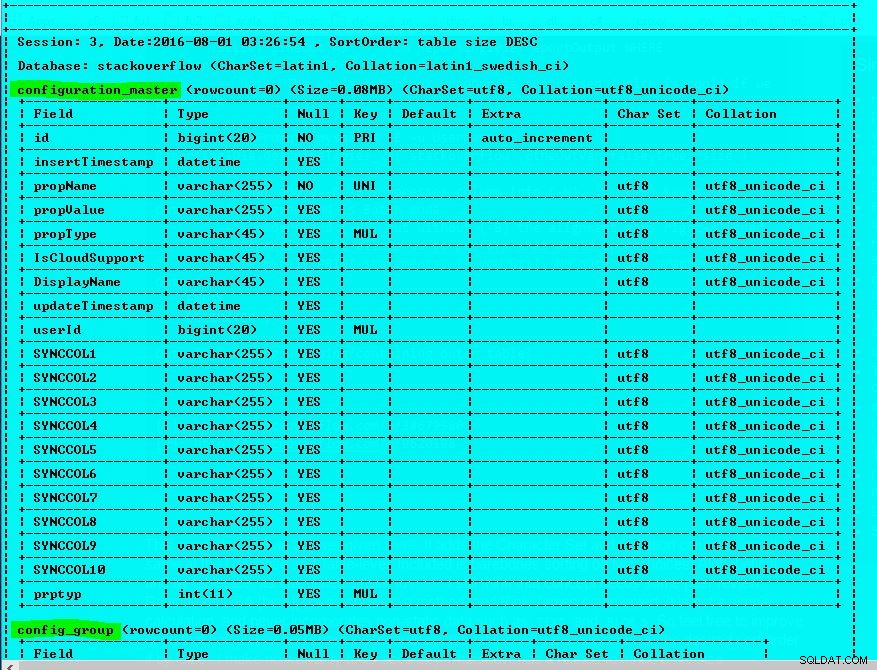
Output2 (Linha de comando usando
-N -B interruptores) que removem a mesa de embalagem externa. Veja o exemplo acima em Saída seção para uso. Efetivo permite comandos como PRINT no MySQL. 